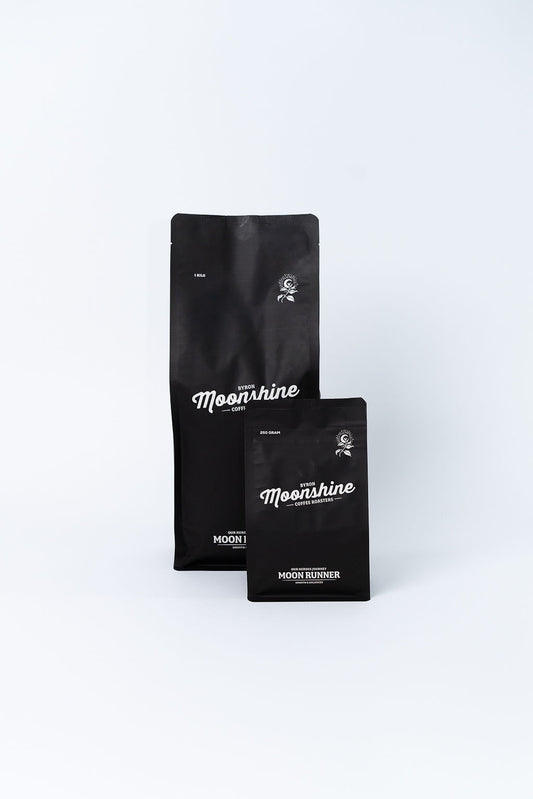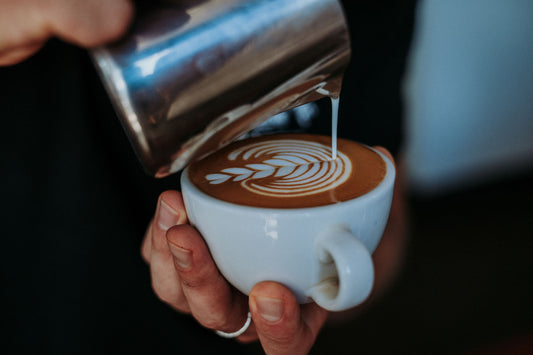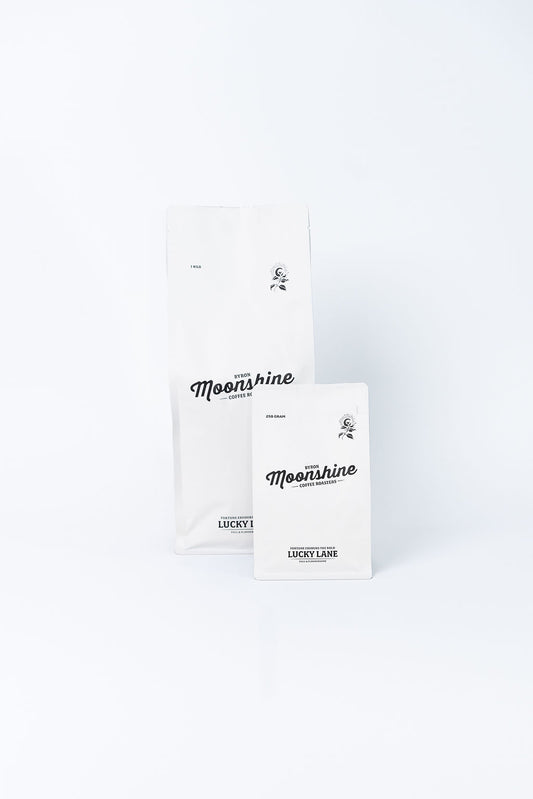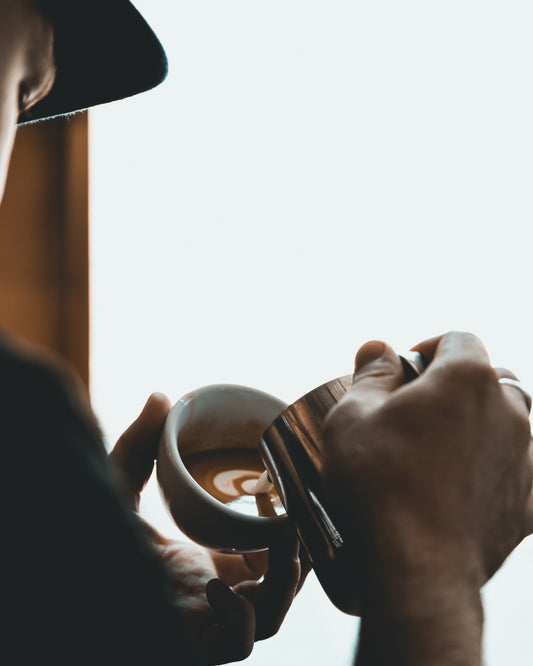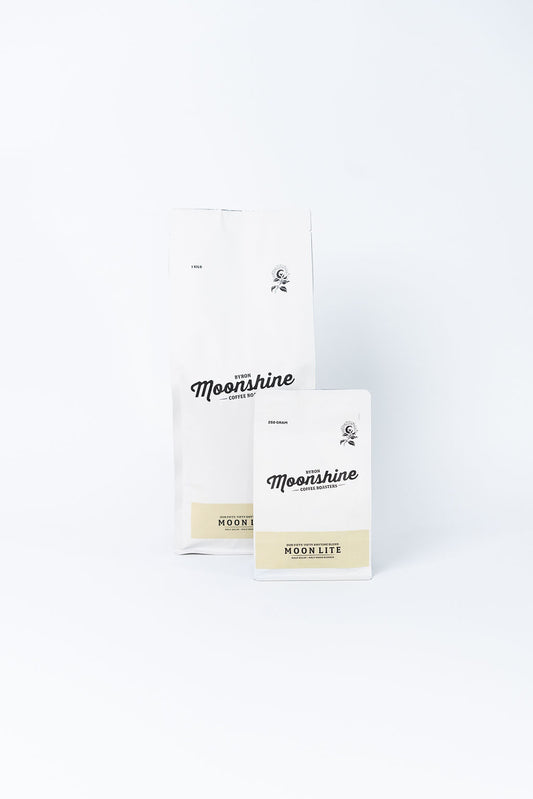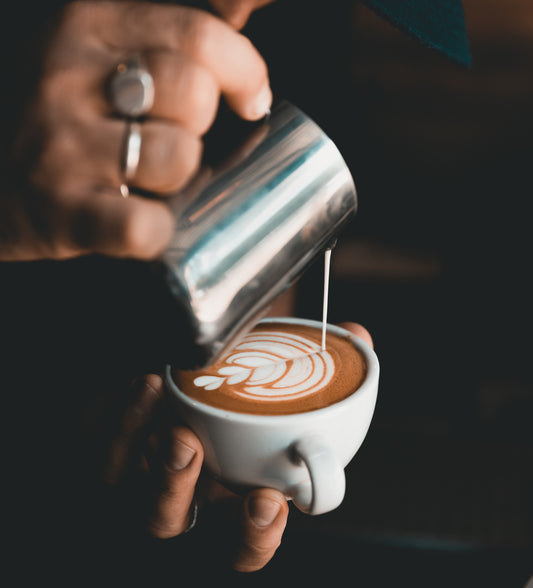Espresso Coffee at Home
If you are chasing those intense, complex flavours that only espresso can provide, you will have gone out and purchased a coffee machine and grinder to get that magic fix in your very own kitchen. And it’s after a couple of cups that you are confronted with a puzzle. You realise there are lots of steps in the process, and potentially each one of those steps can lead to a flavour disaster. That’s okay, it’s not too difficult to achieve consistently great coffee at home if you can take a few things into consideration.
Can I just do something simpler?
Of course you can. There are lots of ways to make coffee at home, and the simplest method is to use Byron Moonshine Organic Instant Coffee! You might use a simple filter brewer like a plunger or pour over to create a tasty filter coffee brew. And you might have a Stove Top coffee brewer for a larger kick in the cup flavour wise. Go for it, but today it’s espresso we’re talking about.

So where do I start?
The key element is to ensure you have the best blend and roast profile for espresso coffee. Our Byron Moonshine Coffee Organic Moon Runner Blend is the perfect balance of flavour and body for home espresso. A great place to start your espresso journey!
So is really fresh coffee great for espresso?
Here’s an interesting fact - super freshly roasted coffee doesn’t make great espresso. Freshly roasted coffee is volatile, with high levels of gas and acids blasting out with every brew. This release of volatiles accounts for why there is a one-way valve in every coffee bag, allowing those elements to escape in a controlled way. Over time, this will lead to coffee staling, but there is a window of around 7 to 21 days from the roast date when these volatiles have stabilised to a point that we can reliably extract the best flavours of the roasted coffee.
When you are purchasing coffee, whether from one of our retail stores or online from Byron Moonshine Coffee you will always see a roast date, not a best before date, stamped on the bag. And be sure to keep those beans in the cupboard, not the fridge, in a cool and dry place.
I’ve got my coffee beans sorted. What’s next?
In essence the process of making espresso falls into four simple steps:
- Grinding the coffee quite finely
- Putting the ground coffee into the portafilter basket
- Compressing the ground coffee using a tamper
- Passing hot water through the coffee grounds at high pressure
So simple! Now let’s explore each of these steps.

Is there a trick to grinding for espresso?
You can purchase coffee pre-ground for espresso - the team at Byron Moonshine Coffee can pre grind your beans in store or via an online order. They will choose a setting that will work for most coffee machines - what we call an omni grind. But for best results, grinding your own beans fresh and adjusted to local conditions will give you the most flavoursome and consistent results.
A burr grinder will produce particles of coffee that are even in size. Upgrade your grinder from a whizzy spice grinder - for espresso you need a grinder that tears the coffee between two burrs. Conical burrs give the fastest and best results. The grinder should be clean, both the hopper, which builds up oils if the beans are left in there for a period of time, and in the collar of the burr grinder, where oils form a gunky grime that gums up the mechanism. A warm soapy wash of the hopper and a brush out of the grinder collar with a small paintbrush on a regular basis will keep your grinder in working order.
It’s important to adjust your grinder from time to time. As your coffee beans age, they get a little smaller and less dense, so you’ll need to grind them slightly finer to achieve the same grind size. When you get a fresh bag, you’ll need to adjust the burrs again to allow for the denser, larger beans to grind effectively.
The key is to grind the beans very fine. It’s common for home espresso makers to grind their coffee quite coarse, but to make a tasty brew the burrs need to be very close together, probably on one of the smallest settings you can adjust them to.

How much coffee should I put in the portafilter basket?
How much coffee you put into the filter basked in your portafilter will influence the way the hot water reacts with the ground coffee, and hence the final flavour. The portafilter basket needs to be full when dosed, and then once compacted with a tamper should have a small amount of room between the bed of ground coffee and the rim of the basket, to allow the group handle to fit into the group head. If you put too much coffee in, it’s difficult to insert the group handle at all, and too little and the water will flow around the ground coffee rather than through it, leading to a watery and bitter cup of coffee.
All filter baskets come with a recommended dosage, expressed in the number of grams by weight. Commercial machines have deep baskets up to 22 grams or more per dose, and domestic machines will have anything from 8 grams to 18 gram baskets. Quite often your machine will come with a deep and a shallow basket, and we recommend always using the deepest and largest one each time you make a coffee. More coffee, more flavour!
Being consistent in your dose is helped by having a set of scales to measure your ground coffee on. A difference of 0.1g can change the way your coffee tastes, so dose consistently for the basket you are using and you’ll see a marked improvement in the coffee you are making at home.
Now put your (s)tamp on it!
Compressing the coffee with a tamper removes the air spaces between the coffee grounds, and encourages the water to pass through the coffee, not around it. Pressing firmly and making a flat surface forces the water, which is under a lot of pressure, to interact with the coffee without causing a channel through to the bottom of the filter basket. One or two firm compressions will do nicely and try to tamp the same way and number of times so that you achieve a consistent result.
Note that a lot of tamps that come with domestic coffee machines don’t fit neatly inside the filter basket rim. They are often quite a bit smaller. It’s worth hunting out a tamper that fits neatly (try our online store for a range of tampers) to get an effective tamp happening at home.

So now I just add water?
Once you hit the go button, the machine does all of the work, and you’ll discover if your grinding, dosing and tamping has been effective. What you should see is a short delay from when you activate the pump to when coffee begins to drop into the cup (3-6 seconds). This is evidence that the water is having to make its way through the ground coffee from top to bottom without any channels forming.
The stream of coffee that emerges from the portafilter should be thin and rich with crema, which will pool with a golden glow at the bottom of your cup. As the water continues to move through the now saturated ground coffee, the flow of water will speed up, and the colour of the extracted coffee will move from golden to yellow, and the flow being to falter and stutter (guttering is the term used, like water flowing out of an open rain gutter). If you are manually activating the coffee machine, turn off the flow of water just as this begins. If it is an auto programmed pour, you may want to adjust the flow of water to a lower amount. You should turn off the water flow around 25-30 seconds after you have activated the pump.
If the flow of water is really fast, and the resulting coffee is pale and bitter, check your dose to ensure the basket is full. If that’s okay, you will need to make the coffee finer to force the water to interact more with the coffee. Adjusting your grinder finer to get an even extraction might take one or two goes, but once you have found the correct dose and grind, you will only need to make minor adjustments from time to time to account for the aging of your beans.
And if your machine is measuring such things, espresso brews brilliantly in 92-96 degrees celcius water at 9 bar of pressure, so achieving these target temperatures and pressures will ensure quality and consistency.
The result should be an aromatic espresso with a full body, complex flavours, a lingering pleasant aftertaste, that elicits a satisfying ‘ahhhhh’ sound. If it’s bitter, watery, astringent, sour, harsh and just unpleasant, it’s back to grind, dose, extract for another round.

I might just go out for a coffee.
We hear you. When your favourite Moonshine barista is able to rock out amazing brews time after time in just a few minutes, the temptation is to just rely on the professionals and buy your brews whilst on the lam.
However, once you know how they produce those amazing coffees, you realise that you could be doing that on demand at home anytime you like, and making them for your family, friends (and frenemies). That’s right, you can be a rock star barista right in your own home.
Espresso coffee making can be a bit of a rabbit hole, chasing that elusive perfect cup, finessing your brew and milk skills to a crazy level of perfection. You knew that coffee was addictive - making it can be just as compelling and obsessive.

